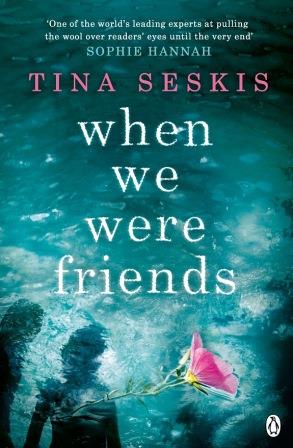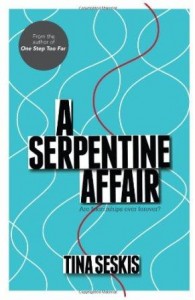
Impulse book purchases.
Sometimes they’re a great idea and you know almost from the first page that you’ll be buying the up the author’s entire back catalogue / future releases. Sometimes it’s better to read a few reviews first to get a better feel for the contents than the cover and blurb provide.
‘When we were friends’ caught my eye during a brief burst of book buying. It looked crime-y, was described as “chilling” and the author, Tina Seskis, was recommended by Sophie Hannah, who’s one of my favourite authors. I grabbed it.
What’s it about?
Six women who have remained friends since university meet up for a reunion. Tensions emerge, secrets are revealed, and by the end of the evening six has become five.
The novel focuses on the relationships between the seven women and how these have been affected their choices in the succeeding twenty odd years.
What’s it like?
Not quite what I expected. Seskis builds tension well in part one as the reunion – a picnic in Hyde Park – begins and underlying tensions are quickly established. Several women don’t even want to attend the meet-up but are forcing themselves to go in the belief that the former strength of their friendships requires this sacrifice. So that bodes well. Not.
Chapters switch between time frames but are only labelled with places, so readers have to pay attention to where each episode ‘fits’ in the women’s shared history. As the reunion disintegrates into tears and arguments, Seskis repeatedly takes us back to the past and shows us how they reached this point, drip-feeding information so that we are constantly on the verge of multiple revelations. This works well, especially since there’s no one story that monopolises your attention, so you’re not impatiently flicking through the pages of one woman’s story to reach another’s.
However, this breadth of viewpoint also means the reader doesn’t really bond with any of the characters, or have a chance to fully appreciate their character. Most of them remain sketches, especially those who are given less narrative attention. This isn’t really a problem; in fact, it’s useful when it’s revealed that one member of the group has been consistently underestimated by the others since their friendships started to drift apart.
Friends and foes
At the heart of the novel is sadness that these friendships have drifted apart. Was it inevitable? Could things have turned out differently? Seskis shows how even at university the women are acutely aware of their differences, though at this point they are generous enough not to voice their real thoughts:
‘Renee’s face hardened under her bleach-tinged fringe, which Juliette secretly thought looked odd against the black of the rest of her hair. She’d preferred it when it was all one colour.’
The central idea seems to be that female friendships are just like that, underpinned by shared experience but wedged apart by unspoken criticism, disintegrating over the years as differences solidify. It’s not a pretty picture, but then almost everyone in the novel is deeply unpleasant at least some of the time. An unethical door-to-door selling company puts the lives of students at risk; the two main husbands featured are both deeply immoral; the two main wives are disinterested wives and / or temperamental mothers, ignoring their husbands’ needs, unable to meet their children’s needs. At times, then, this is quite a depressing read, with a sense that past possibilities have shut down and the best years of their lives have been and gone.
Minor notes
- Seskis tells us frequently how beautiful Juliette is. This got irritating…although in hindsight I think there might be a reason for this.
- We learn that Natasha’s husband is having an affair with one of her “friends” – but in order to maintain secrecy there are awkward constructions like ‘Natasha’s old friend…’ even as the adulterous couple are having sex. The same is true of scenes following the reunion. In order to hide which friend has disappeared, Seskis relies on constructions like ‘she thought of how her friend had run off in hysterics’, which feels so, so awkward when we’re in their consciousness.
- As time moves forward at the end of the novel, we learn some developments in a very abrupt way which jolted me out of the narrative.

Not sure why the title was changed.
- This was previously published as ‘a sepentine affair’.
Final thoughts
I think I judged this harshly when I first finished it. The characters were (mostly) unpleasant, their lives were awful (with one or two exceptions) and, most crucially, it wasn’t quite what I’d expected. Perhaps this last point is why, as I’ve had time since to reflect on the book, I’ve realised that I really quite enjoyed it. Seskis does a superb job of capturing life: the way your past traps you in a defined role, the way your choices can feel like they weren’t yours to make, the way friendships can shift to become a guilty burden rather than a vital support.
It’s not crime-y, even though there’s a PI involved in the tale, but it is quite chilling in places, and might make you consider whether those friendships you’ve been clinging onto have become toxic. Could it be time to let the past go?
2 Comments
Emma this is ace. Your reviews are so considered and well-written (time for that novel?!) just wondered if you would have picked up the book had it still had the previous cover and title of The Serpentine Affair? Thanks so much for my review, btw. I loved it. x
Hi Rebecca. Many thanks for your kind words; I am glad you liked my review of ‘The Exclusives’.
Would I have picked up this same book with the earlier cover and title? Um, no. ‘A Serpentine Affair’ has connotations of something convoluted and yet also possibly more comic than the contents actually are. And the new cover is far more enticing with its watery depths and intriguing reflections. So I suppose I do know why it was changed!
I hope you are well and your own book writing is coming along nicely.